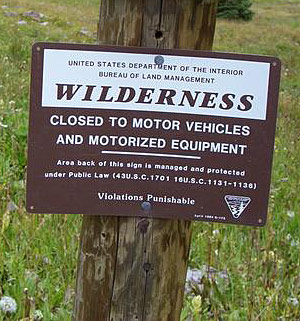Bicycles belong in wild places.
Bicycling and Wilderness
What is “mechanical transport”?
The Wilderness Act of 1964 states that there shall be no “mechanical transport” in Wilderness. (See actual text in sidebar.) What does this mean? Does the phrase mean the bicycles are banned by that law?
Potential sources of guidance include the legislative history of the Wilderness Act, the interpretation of the clause by federal agencies, legal scholarship, by examples of uses the word, and in meaning and logic in the English language.
The paragraph in which the clause occurs prohibits a number of activities, such as permanent roads and commercial enterprise. It particularly prohibits motor vehicles, motorized equipment, aircraft, and “no other form of mechanical transport.” Does that clause mean “more things like we have already listed,” or “other kinds of things that are not listed here”? There is nothing in the Act itself, nor in other official Congressional language, to indicate which of those approaches the legislators intended in the early-1960s. Mountain bicycles were not yet known, so they were not addressed.
In a law review journal article, "Congress's Intent in Banning Mechanical Transport in the Wilderness Act of 1964"1, attorney Theodore Stroll traced many of the ideas expressed by members of Congress as they debated the proposed Wilderness Act. They spoke of a nation whose people were growing flabby, who need the benefits of outdoor recreation propelled by their own muscles. They wanted people to appreciate Nature through non-motorized travel. Alarmed in Cold War times by a nation whose people were not engaged in strenuous physical activity.
Only national forests had Wilderness in the initial Act and the U.S. Forest Service was charged with implementing the law. The agency wrote rules that provided more specific interpretation to the Act. Regarding mechanical transport, the rule, published in 1966, specified that “Mechanical transport, as herein used, shall include any contrivance which travels over ground, snow, or water on wheels, tracks, skids, or by floatation and is propelled by a nonliving power source contained or carried on or within the device.” (emphasis added) The word “and” is critical here, for it means a device is not mechanical if its power source is alive. This rule remains in the Code of Federal Regulations at 36CFR Sec. 293.6(a). In the mid-1980s, the U.S. Bureau of Land Management and the National Park Service adopted identical language, except they added the clause, “or is a bicycle or a hang glider.”2
The English language also offers apparently conflicting answers to the question of this essay. A 1964 edition of Webster’s College Dictionary defined “mechanical” as “having to do with machinery or tools” or “produced or operated by machinery or a mechanism.” The word “machine” in that book defined:
ma-chine, n. 1. [Rare or Archaic], a structure or built-up fabric of any kind; specifically, the human or animal frame. 2. a) a vehicle, as formerly, a carriage, cart, etc.; b) a vehicle operated mechanically; specifically, an automobile. 3. a structure consisting of a framework and various fixed and moving parts, for doing some kind of work; mechanism; as a sewing machine. (4.-7. not relevant) 8. in mechanics, a device that transmits, or changes the application of energy: the lever, wheel, and screw are called simple machines.
The essence of the semantic problem is that “mechanical” and “machine” refer either very specifically to motorized equipment or very generally to all sorts of devices.
The federal agencies’ actual practices offer some guidance. Consider these various types of travel that are allowed in Wilderness:
- Oar-powered rafts use levers to magnify the power of human arms.
- Backcountry skis allow humans to move above snow that would otherwise engulf them. Legs connect to the boards through complex, spring-loaded bindings.
- Climbers sometimes resort to “Jumar ascenders,” a spring-loaded cam device that grips a rope more securely than most people can hold with their hands. They also use simple screws to grip ice and spring-loaded carabineers to make rope and anchor connections.
- Hikers sometimes travel with poles, like cross-country skiers, which they use to speed or stabilize their movement. Some hiking poles are spring-loaded.
- Sea kayaks have rudders that move when the person pushes her foot on a pedal and a linkage mechanism transmits the force to the back of the boat.
It can also be argued that shoes and saddles are, to use Webster’s words, “a structure consisting of a framework and various fixed and moving parts, for doing some kind of work” and “a device that transmits, or changes the application of energy.”
Going a step further, some have argued that we allow the use of radios, computers, stoves, and other devices that are clearly machines. However, these do not relate to transport and thus fall outside this discussion.
So there is plenty of room to argue about mechanisms and machines. But most bicyclists ask the federal agencies, “You allow all these high-tech, complex transportation devices. What makes bicycles so different? , why do they not allow bikes? Is there a clear feature distinguishing shoes from saddles from bikes? Or is there a continuum of increasing complexity, a scale along which someone draws a line which we may or may not call arbitrary?
We hire USFS, BLM and NPS to do exactly that, draw the line based on judgment. But in this case I must question the quality of the judgment. It does not seem well considered and it does not address the complexity of the issue.
This is a matter of philosophy that we can debate. Is it a worthy debate? How relevant to reality?
1. Congress's Intent in Banning Mechanical Transport in the Wilderness Act of 1964
2. This probably means skateboards and wierd devices like land-xc-skis are legal in BLM and NPS Wilderness.
